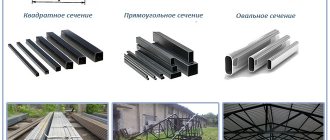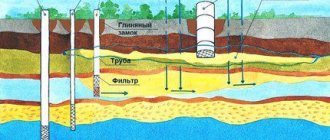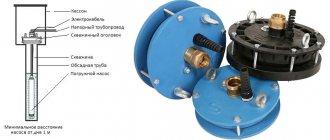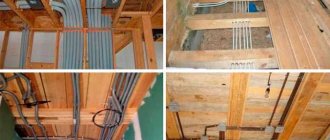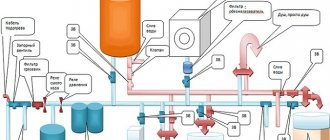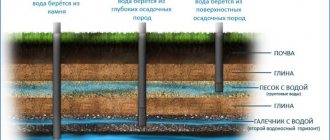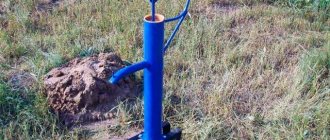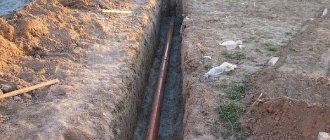Drilling a well on a site is a large-scale task. Not every home owner can afford the services of a professional team, and hiring “handicraftsmen” is, in most cases, just throwing away money.
It’s easier to do all the work yourself: you work harder for yourself and have fewer expenses. In addition, if you make a drilling rig yourself, the costs will seem literally ridiculous compared to the real prices of drilling.
We will tell you how to make a machine for manually excavating a water intake on a site. The information we present is based on the practical experience of independent drillers. To complete the perception of a difficult topic, the proposed information is supplemented with useful diagrams, photo collections, and videos.
Advantages of a DIY installation
- Relatively low cost. Ready-made drilling rigs are several times more expensive than their homemade counterparts. At the same time, a homemade mechanism will be in no way inferior to a more expensive factory-assembled installation.
- The technical characteristics of a homemade unit are fully consistent with factory-made equipment.
- Compact size and relatively light weight.
- Ease of use and maximum mobility. With the help of a small homemade installation, it will be possible to drill even in the most inaccessible areas.
- High speed of assembly and disassembly.
- Ease of transportation - a disassembled homemade drilling rig can easily be placed and transported in a light trailer.
Increasing power
The power of an automatic electric drilling rig does not exceed one horsepower. But this value can be increased. It is enough to install a gearbox, on the shaft of which a flange is attached with another flange already fixed on it with bolts. A rubber washer of the required thickness is placed between the flanges and takes on part of the shock loads, smoothing them out.
This helps to avoid problems that arise during drilling. An electric drilling rig cannot fully operate without water. It must be supplied to the place where the soil is in contact with the elements of the device. Supply can be carried out using a special device, which is placed just below the level of the gasket between the flanges.
A drilling device is really necessary in a country house or country house. In addition, the presence of such a device is justified by its relatively easy assembly when studying the entire technology, as well as the possibility of reusable use even outside the site, that is, for your own business. The main thing is that the drilling mechanism copes well with the task of drilling wells, so your site is guaranteed a constant and high-quality water supply.
The simplest design of a screw MGBU
Screw mechanisms are a more complex device than impact devices. The most important working unit of such a machine is a rotating spiral screw. To make it you will need to take a piece of steel pipe d 100mm. The petals of the auger are welded in the form of a spiral at the bottom of the pipe, and two sharp knives are welded at the very bottom end. The petals and spiral are made of sheet steel, 3-4mm thick.
A thread is cut on top of the pipe so that a fastening coupling and a special tee can be attached to it. A tee is a special device for turning a drill in the form of a metal coupling, to which pipe-levers are welded horizontally on both sides. It is screwed onto the upper end of the pipe with a screw at the end.
As the auger rotates, it will go deeper into the ground. And when it protrudes above ground level, the tee with levers is screwed together, and a fastening coupling and the next pipe are installed instead. The drill is placed on top of it again, and the whole procedure is repeated from the beginning.
Advantages of do-it-yourself manual drilling
Manual drilling with self-made devices has the following advantages over automatic drilling methods using special drilling equipment by individuals and organizations:
Cheapness. Making a drill with your own hands from scrap materials and drilling a well without the involvement of third-party assistants, specialists, or organizations is the most profitable option from a financial point of view if other methods of employment in your free time do not bring monetary income.
Versatility. Independent manual drilling work is universal due to the following features:
- Manual drilling in many situations is the only possible option for carrying out work, if entry into the site of special equipment is impossible or the well is located in a built room.
- Narrow borehole channels are laid manually without the use of casing columns of standard diameter, which significantly reduces the cost of organizing and equipping water supply on an individual site.
- Drilling is carried out manually to a depth of 5 to 35 m, which corresponds to the characteristics of an Abyssinian and sand well.
- The drill made can be used for other economic purposes, if it is necessary to make holes in the ground - when constructing fences, planting garden plants, installing pile foundations and other household work. If it is no longer needed, the structure can always be disassembled and used on the farm at your own discretion.
Flexibility of application. Depending on the depth of the water layer, the quality of the soil and the dimensional parameters of the borehole channel, various drilling technologies, designs of drilling devices or combinations thereof are used. With individual manufacturing, there is always the opportunity, through experimentation, to independently make a drill for a well, the most convenient and effective for specific conditions.
Of course, you will have to pay for the low cost of the manual method in the speed of work and intense physical labor, the latter being to some extent useful in terms of improving health.
How to make a support and assemble the installation
The frame of the auger installation is made approximately as follows;
- weld a quadrangular base from a profile pipe;
- install three racks made of 25 mm pipe;
- put pieces of pipes with a diameter of 32 mm on the posts;
- weld a horizontal carriage under the gear motor to these elements;
- A triangular frame is welded to the upper ends of the racks.
When installing the installation, the supporting pillars of the frame are fixed exactly in the middle of the sides of the rectangular base. This will subsequently ensure the stability of the tower. Next, the portable structure assembled in this way is installed at the well drilling site. An electric winch is mounted on the top frame of the tower. A gear motor is installed on the carriage.
Then the pump hose, motor and drill are connected through a swivel. The water pump for an auger drill must be powerful enough. Otherwise, the drill will subsequently begin to get stuck in the ground. After assembling the installation, you can connect all the necessary equipment to the electrical network and begin the actual work of hydraulic drilling the well using standard technology.
What is the work of a do-it-yourself hydraulic drill?
Hydrodrilling involves breaking up soil using drilling rigs under pressure.
It is provided by the mass of the rod and auxiliary drilling equipment. These tools also flush the well using drilling fluid. To drill a well, you will need a small-sized drilling rig. It must be purchased or rented.
The washing liquid has a fairly simple composition - water mixed with clay. The liquid flows into all the pits around the drilling site, which are designed for the free movement of water. The drilling fluid is fed into the well using a motor pump.
Flushing fluid functions:
- Drilling rig cooling;
- Grinding the walls of the well;
- Washing away dirt from the source.
The drill string slowly moves down. The length of the tool is increased by connecting auxiliary sections. After reaching the required depth, the well is flushed with water. Next, a pump is installed at the source and the well begins to operate. The length of the well depends on the aquifer. The cheapest option is considered to be drilling an Abyssinian well. Artesian horizons are also distinguished.
Types of drilling rigs
Mini drilling rig
The units under consideration are classified according to the characteristics of well drilling methods.
Thus, when performing percussion-rope drilling, the soil is destroyed by a heavy load tied to a support frame, the ribs of which in most cases are connected into a pyramid. The weight is simply lifted up and thrown down as many times as necessary to create a recess of the desired size.
Drilling wells using the percussion-rope method
Rotating drills are both simpler and more difficult to use. Such equipment requires much less physical effort on the part of the performer, but the design of such drilling rigs is more complex - many of the components of the system simply cannot be made with your own hands without special equipment and appropriate skills.
Well drilling diagram
As a result, some of the necessary elements have to be purchased or ordered. However, the cost of this is still significantly lower when compared with the cost of a factory-assembled installation.
In general, there are 4 main types of drilling rigs, namely:
- units operating using the shock-rope method. Externally, this design looks like a frame with a triangular base. A strong cable with a bailer is attached directly to the frame;
- screw-type installations. When such equipment is used, earth excavation is carried out using a special auger. The hole in the ground is not washed out during the drilling process;
- rotary units. They operate using the principles of hydraulic drilling;
- rotary hand mechanisms. The simplest type of installation. The design does not include an electric motor - instead, physical force is used. It requires irrationally large labor costs, so it is used extremely rarely.
What do you need to get started?
Naturally, it’s not possible to just go and make a drilling rig. To do this, you need to prepare first. It is advisable that at the time of assembly you have minimal experience with welding. This will make your life much easier, since you will not need to involve specialists or friends. You should also have an electric drill and grinder on hand. We will look at why all this is needed a little later.
But this is not the entire list of tools. It will be difficult for you to do without a device for creating external threads, as well as an adjustable wrench and a plumbing cross. The material we need is a galvanized pipe and a ½ inch bend. In our case, a special coating is necessary, since if there is no zinc, the pipe will quickly rust. There is nothing good in this, since replacing it is a very problematic task. Well, now let's move on to the practical part of this article.
Drill for percussion-rope drilling
You can drill a well on a site not only by rotating the drill, but also by the percussion-rope method. This type of work requires a special installation, which can also be made independently from scrap materials.
Having such equipment, all work can be performed without any assistants at all, so we will also consider the process of making an impact drill.
To drill a well using the percussion-rope method, you don’t need much: a stable tripod frame, the impact drill itself, a strong cable and a winch
To understand what and how we will make, let us consider in general terms the essence of shock-rope work.
From a great height, a projectile pipe - a bailer for a well - is dropped into the location of the future water intake point designated with a shovel or auger. An eye for the cable is welded to the drill at the top.
A hole is cut in the top side to extract the drilled rock.
The lower edge is sharpened or equipped with teeth that optimize soil loosening. A ball or petal valve is installed inside the pipe 5–7 cm above the nominal bottom to capture and hold loose rock.
A bailer is an indispensable tool when digging through loose sand, pebbles, and gravel deposits. It is often used in combination with other drills. They alternate with an auger or glass, which is not capable of removing loose and water-saturated deposits.
Loose soil particles are retained inside the bailer thanks to a valve located at the bottom of the housing. The auger, bell, and glass do not have such advantages.
Rarely is only one drill used to drill a well. Most often they are used in combination: clayey rocks are drilled with augers or glasses, loose and water-saturated rocks are drilled with a bailer
The procedure for dropping the drill is repeated many times. The result of the process is a body that is one-third filled with soil and a hole in the ground that increases by 30-40 cm.
The filled bailer is removed from the barrel using a winch, turned upside down with the hole and cleaned with blows of a heavy hammer.
Then the process of percussion-rope drilling is resumed and repeated until a well of the depth that was planned to be obtained is formed at the site where the drill fell.
It is not necessary to buy a ready-made installation - you can make your own bailer for drilling and cleaning.
If you make such an impact drill heavy enough, then with this bottom it will cut the soil like butter and will not allow it to spill out of its cavity back
In this case, there is no point in creating one drill, so we will tell you how to build the entire drilling rig along with the projectile.
- We select the place where, according to our calculations and assumptions, the well should be located. We mark it out by making a small depression using a regular shovel.
- We install a tripod 2-3 meters high above the hole. We equip the top of the tripod with a well-fixed block for the rope. You will also need a winch, which we attach to the supports. It's good if you have an electric winch, but a manual one will also work.
- We prepare the impact drill itself. For this purpose, we will need a thick-walled pipe, the diameter of which corresponds to the size of the shaft of the future well.
To make a drill, we take a strip of thick metal and weld it to the upper end of the pipe, placing it perpendicular to the longitudinal axis of the projectile.
Along the center line of our pipe, in a welded metal strip, we drill a hole corresponding to the thickness of the rope on which the projectile will be attached.
The lower end of the pipe also needs processing: you can make a serrated or ring sharpening on it. If you have a muffle furnace, you can harden the drill in it after the sharpening procedure.
The drill for percussion-rope drilling is not so easy to clean from the soil that has accumulated in it. To speed up this routine operation, you can make not a window-hole, but a vertical slot passing through almost 2/3 at the top of the pipe.
The bell is part of the impact drill. It is easily cleared of soil and can be replaced, for example, with a chisel if a stone is encountered while drilling a wellThe heavier the drill, the faster you can achieve the desired result, but it is also necessary to take into account the power of the winch, which will have to pull the drill with soil from the wellbore.
So, if its power still allows, the projectile can be made heavier by placing removable metal weights in the upper part of the pipe.
You may also be interested in information on well construction, flushing after drilling and winter insulation, discussed in our other article.
Common types of drilling equipment
Wells for water were made in ancient times. Technology has gradually improved and today there are several drilling methods:
- shock-rope;
- screw;
- rotary.
Percussion-rope drilling
The shock-rope installation consists of a pyramidal support frame with a rope attached to its top. A heavy load in the shape of a glass is attached to the rope, which, when dropped from a height, produces an impact with the ground. Under the influence of gravity, the glass sinks into the ground. Then the glass is removed from the well, freed from the accumulated soil and the operation is repeated until the aquifer is reached. The remaining excess soil in the well is washed away with water from the reached aquifer.
The weight of the cargo reaches several tens of kilograms, so a manual or electric winch is used to lift it. You can also lift using muscle power. The load is released using a special coupling.
All you need is a few metal corners, a pulley, pipes and rope. Even a novice welder can perform welding work. Another advantage of the shock-rope method is that when drilling a well, its walls are not destroyed, but rather compacted. This method can be used in the absence of rocks.
Auger installation
The working tool of the auger installation is an improved Archimedes screw. The basis of the auger is a pipe with a cutter at the end. The soil loosened by the milling cutter rises up the auger blades. If you use drills with an auger along the entire length and increase the length of the auger during drilling, then all the waste earth will be fed directly to the surface.
The auger can be driven by any engine with a gearbox. In shallow wells, you can even rotate the auger manually.
Rotary drilling
There are areas where there are many inclusions of hard rocks or stones. In these cases, the use of installations with rotary bits will be more effective. A rotating carbide bit is located at the end of the bit. When the drill rotates, the crown destroys the soil, which is removed from the well with water. This is a very effective method, but to give the drill the required rotation speed you will have to use a powerful motor.
The soil washed out during drilling must be removed from the site so as not to turn the area into a swamp. In addition, the installation is large and weighs a lot. Moving it around the site is difficult. To manufacture such a drilling machine, high precision machining of parts is required.
How to make a high-quality drilling rig yourself?
The most common reason for using drilling equipment is to extract drinking water.
A particularly urgent task is to drill drinking water wells at significant depths.
Many summer residents and owners of private estates prefer to involve professionals and special drilling rigs to solve the problems under consideration, however, it is possible to obtain high-quality results without the involvement of specialists and professional equipment.
Since prices for such services start from one hundred thousand rubles and above.
Thus, it is quite possible to make a drilling rig with your own hands, and then do all the necessary work yourself. The relevance of handmade production lies primarily in the price.
It is quite possible to make drilling equipment yourself. So, below we offer all the information necessary for the production of the type of installation in question. First you need to prepare tools and materials.
Swivel homemade drilling rig drawings
Tools and materials:
- A hacksaw for metal, or an angle grinder with a disk for cutting metal;
- Adjustable wrench No. 1;
- Tools for cutting external inch threads - dies;
- Half-inch diameter steel pipe;
- Cast iron sanitary cross;
- A half-inch diameter squeegee.
After all the tools and materials have been collected, you can begin work, the intricacies of which will be discussed further. The procedure for manufacturing a mini drilling rig begins with the preparation of pipe sections of the required diameter, which will subsequently serve as the main elements of the device.
Diagram of a support for a homemade drill
Algorithm for creating a manually driven system:
- To fix the pipes in a cross, a thread should be cut at their ends, the length of which will be 2 cm;
- You will need to weld steel plates on the end side to several sections of pipe of varying lengths. The pointed plates will play the role of tips;
- To simplify drilling, as well as remove soil from the work site, a constant supply of water is provided to it;
- To solve this problem, a hose from a pump or water supply is connected to one of the holes of the cross using an adapter of the required diameter;
- Next, all parts must be installed in the holes of the cross on the thread using plumbing PVC tape or hemp fiber;
- You will need to attach the most insignificant section with a tip to the bottom of the pipe by means of a bend;
- Upon completion of drilling a well, the depth of which reaches one meter, it is necessary to replace the tip with a piece of pipe of greater length.
Of course, creating a compact drilling rig with an electric drive is an opportunity to simplify the work. An automatic drilling mechanism powered by electricity is much more efficient, works better, and makes holes in the soil faster.
Double-support hand-made drill on wheels
DIY drawings for a hydraulic drill
To create a drilling rig you will need to make drawings. They include a diagram of all the parts of the hydraulic drill and their construction. The dimensions of the small-sized design are quite compact.
Hydraulic drill diagram:
- Collapsible frame;
- Mechanical winch;
- Boer;
- Engine;
- Swivel (used to slide all elements);
- Motor pump;
- Drill rod;
- Fluid supply hoses;
- Control block.
The drill swivel and rods must be purchased from a specialized store. The professionalism of the tool is very important, since a large load is applied to these parts. You can order parts from a specialist. It is better to choose modern CNC machines. It is also necessary to select certain types of steel.
Specialists with private businesses do not do good training. After this, sanding is necessary. It is recommended to use HCV hardening, but this will cost more.
Factory samples will help check the quality of work. It is enough to compare homemade and factory parts. This is how the thread is checked. For a high-quality model, the match must be perfect.
Other models of drilling rigs
In general, the assembly process for most existing types of drilling rigs remains the same. The frame and other elements of the structure under consideration are prepared according to a similar scheme. Only the main working tool of the mechanism can change.
Read the information about making different types of installations, make a suitable working tool, and then attach it to the support frame and connect it to other required elements, using the recommendations from the instructions discussed above.
Drilling rig with "chuck"
Drilling rig with "chuck"
The main working element of such a unit is the cartridge (glass). You can make such a cartridge yourself from a thick-walled pipe with a diameter of 100-120 mm. The optimal length of the working tool is 100-200 cm. Otherwise, be guided by the situation. When choosing the dimensions of the support frame, you will have to take into account the dimensions of the chuck. Think over everything so that in the future it will be convenient for you to use the finished drilling rig.
The working tool should have as much weight as possible. Make triangular points from the bottom of the pipe section. Thanks to them, the soil will be loosened more intensively and quickly.
DIY drilling rig
If you wish, you can leave the bottom of the workpiece flat, but it will need to be sharpened.
Make several holes in the top of the glass to attach the rope.
Use a strong cable to secure the chuck to the support frame. Select the length of the cable so that in the future the cartridge can freely rise and fall down. In this case, be sure to take into account the planned depth of the source.
To increase the efficiency of excavation work, you can connect the assembled installation to an electric motor. In such a situation, the cable with the cartridge will be wound on the gearbox drum.
It is possible to ensure that the face is cleared of soil by including a bailer in the structure.
Using this installation is very simple: you first manually create a recess at the drilling site with a diameter greater than the diameter of the working cartridge, and then begin to alternately raise and lower the cartridge into the hole until the required depth is reached.
Simple screw installation
Homemade auger
The main working element of such a mechanism is the drill.
Drilling auger drawingDiagram of interturn auger ring
Make a drill from a metal pipe with a diameter of 100 mm. Make a screw thread on the top of the workpiece, and install an auger drill on the opposite side of the pipe. The optimal drill diameter for a homemade unit is about 200 mm. A couple of turns is enough.
Drill disk division diagram
Attach a pair of metal knives to the ends of the workpiece by welding. You must secure them in such a way that when the installation is placed vertically, the knives are positioned at a certain angle to the soil.
Auger drill
To make it most convenient to work with such an installation, connect a piece of metal pipe 1.5 m long to the tee. Fix it by welding.
The inside of the tee must be equipped with a screw thread. Screw the tee itself onto a piece of a collapsible one and a half meter rod.
It is most convenient for two people to use such an installation - each worker can handle a one and a half meter pipe.
Drilling is performed in the following order:
- the working tool goes deep into the ground;
- 3 turns are made with the drill;
- the loosened soil is removed and removed.
Repeat the cycle until you reach a depression of about a meter. Afterwards, the rod will have to be extended using an additional piece of metal pipe. A coupling is used to fasten pipes.
If you plan to construct a well deeper than 800 cm, fix the structure on a tripod. At the top of such a tower there must be a hole of sufficient size for the unhindered movement of the rod.
During the drilling process, the rod will need to be periodically increased. As the length of the tool increases, the weight of the structure will also increase significantly; it will become very difficult to operate it manually. To conveniently lift the mechanism, use a winch made of metal or durable wood.
Now you know in what order simple drilling rigs are assembled and how to use such units. The knowledge gained will help you save significantly on the services of third-party drillers.
Good luck!
Ways to improve the tool
When drilling holes, the master may encounter a large number of plant rhizomes that lie tightly in the soil. The sharp edges of the blades will make working with the drill much easier. For ease of use, you can cut several teeth on the sloping area of the blade or round off its cutting area.
You can improve the design and make removable cutters for the drill. Thanks to them, it will be possible to drill holes of any diameter. In addition to the manufacture of spare parts, it is necessary to provide for their attachment to the collar. The easiest way is to connect them with two iron plates, which are secured by welding.
In the mounting plates, as well as in the blades, you need to drill two holes for the sides. The cutters are fastened with M6 bolts. To ensure that the bolts do not interfere with work, they must be screwed in with the threads facing up.
There is another way to improve your homemade pole drill. You can increase the efficiency of the lower end of the knob. To do this, you need to cut out a narrow metal plate (10x2 cm) and grind it into a cone shape using a grinder, making a kind of point.
There is no need to make cuts in the collar; turned metal plates are inserted into its end, fixed by welding and flattened. The result should be a peak.
There is another method for making a pike. A metal plate is cut to a length of about 17 cm and a screw is made from it, similar to a corkscrew. Further, the algorithm of actions is the same as in the described first option.
A suitable drill can act as an auger, which can easily handle wood as well as metal. Such a tool will penetrate the ground much easier and will drill a hole to the required depth without any problems.
Builders who work on dense deep layers of soil will need one piece of advice. Between the pick and the cutter you need to weld a small flat cutter. Thanks to this design, it will be possible to loosen the earth and center it when drilling. For such a part you will need 2 metal plates 3x8 cm. This trick will significantly speed up working with the tool.
Milling cutters can also be made from grinder discs, which are designed for working with stone. The circles need to be cut along the radius and the hole in the center should be expanded according to the diameter of the knob. Bending the disk with the sides apart gives the appearance of a corkscrew or auger. All that remains is to weld the part in the manner described above.
The cutter is very easy to make from a circular saw blade. The teeth of this model can easily cope with plant rhizomes and hard soil.
The master can choose how to modernize his drill independently. It is worth saying that making a drill for poles with your own hands is not a complicated process at all and requires minimal physical and financial costs from the master. The entire manufacturing process takes two hours at most.
Finally, there is one important piece of advice: before the drilling process, it is best to loosen the soil with a shovel, then the device will fit into it more easily and the work will go much faster. The recommendations given will certainly help the master make a functional and effective tool that will serve him for decades and become a very good assistant.
Making a petal bailer
If desired, such a working tool can be made for a small-sized impact drilling rig. A petal bailer is made using approximately the following technology:
- they also cut off a piece of about 1 m long from a thick-walled pipe for the body;
- a piece approximately 15 cm long is cut from a pipe of smaller diameter;
- a circle is cut out of sheet steel, the diameter of which should be equal to the diameter of the insert cut out at the previous stage;
- the valve is welded onto spring hinges;
- grind off the lower part of the insert.
At the final stage, the structure made from a 15 cm piece is tightly inserted into the bailer body and secured with a bolt.
Making a petal impactor for a drilling rig is therefore easier than making a ball impactor. However, such designs are still considered less reliable. Ball bailers usually last much longer than petal bailers.
Making a screw drill
Assembly diagram for a homemade drill.
In the factory version, the auger drill is a strip sharpened and bent into a spiral, welded to the pipe. It is made from high-strength tool steels. At home, you can make a simpler version of the tool. It is not difficult to make a drill with your own hands if you have welding and plumbing tools.
The basis is a round metal profile or a thick-walled pipe. A tip is welded to its end, which will serve as a guide during drilling. The tip can be made from a steel strip. To do this, it is heated and bent into a spiral. The lower end is sharpened to a cone. For reliable fastening to the pipe, a slot is made in it, into which the upper edge of the tip is inserted, after which the structure is tightly welded.
Screw drill drawing.
The next step is installing the knives. The cutting blades of the drill are shaped like a semicircle. They are made of steel with a thickness of at least 3 mm. A good solution would be to use halves of a circle with a diameter of 100-150 mm from a circular saw. The steel used in the circles is highly durable, and the teeth will help cut not only the soil, but also the roots of plants. The blades are welded at a distance of 20 cm from the tip of the drill at an angle of 15-20 degrees to the horizontal plane. Thus, the angle between them will be 30-40 degrees. Alternatively, two or more rows of blades can be installed on a well drill. Most often, blades of smaller diameter are installed below the main knives. This allows you to cut into the ground gradually, using less effort.
It is easy to make a rotary handle for a drill. It is enough to weld the holders to the pipe. The handle must be attached to the drill using a detachable connection. As the drill string goes deeper into the soil, it is extended with additional rods. The length of one rod during manual drilling is approximately 1.5 m. Most often, threaded connections are used to connect the rods to the drill and to each other. In some cases, cotter pins and clamps are used. The connections must be reliable, but at the same time easy to disassemble, since it is necessary to lift and dismantle the column to remove soil every 0.5 m of depth.
The auger-type manual drilling rig works well in sand, clay and small gravel.
A little theory
Boers are divided into:
- spoon drills
- coil drills
- drill bits (our case)
Spoon drill
They are used mainly for areas with plastic rocks (soil in the form of a mixture of sand and clay, or simply clay). Here you can use two options. The first option is when the bottom of the spoon looks like a bucket-shaped cutter. Moreover, on the left side it is in the form of a cutter, and on the right - like a transverse protrusion. The second option is to make a spoon from a pipe, choosing a pipe with the most suitable diameter for this.
Coil drill
The drill is similar in appearance to a wood drill. It is used for drilling dense loams. The action of a coil drill is similar to that of a corkscrew. Rotating, it is screwed into the rock. The cutting blade of the serpentine appears in the shape of a swallow's tail. It must be hardened. It will not be easy to make such a drill yourself, so you can simply adapt by replacing it with an ice drill or sections of screw augers.
Drill bits
Used for drilling hard rocks and rocky deposits. For the penetration of various rocks, the sharpening angle used is important here. For hard rocks it ranges from 110 to 130 degrees, for softer rocks – from 30 to 70. Also, bits differ in shape, again depending on the rock. These are the ones we recommend when creating a homemade water drilling rig.
The drill itself consists of a swivel, a drill rod and a bladed drill. The drilling fluid is supplied through the swivel to the hose located inside the rod. It will not be possible to make this part yourself, since this requires precise equipment. If the seal is not completely sealed, solution leakage may occur.
A rod is a device for transmitting rotation from hands to a drill, or from a motor to a drill. Also, as mentioned above, a hose for drilling fluid goes through it. These drill elements range in length from a meter to 1.8 meters. But the length can be increased. This is done using locks with rectangular threads.
A paddle drill usually has two blades and is used directly for drilling. It will also be interesting to know that there are still bailers. They are needed for drilling wells using the percussion-rope method on loose, granular, aquiferous soil layers. Bailers are also used to clean wells after the bit has been worked or from accumulated silt that interferes with the flow of water. On a cable, the bailer is dropped into the face, and soil enters its cavity by opening the valve. When lifted, the valve closes and holds the soil inside the bailer.
As for the tower. Its height is up to five meters. The structure is in the form of a tripod, with a rope block on top. When percussion drilling, a balancer is used here. In this case, the tool with rods is dropped into the face from a meter or one and a half meter height. The balance beam is a strong board or wooden beam.
This concludes our introductory article. As you can see, drilling with your own hands is not such an unsolvable issue. In the next material we will move on to the practical part with recommendations, drawings and approximate estimates.
Several photos and videos of homemade drilling rigs at work.
The process of working with a bailer
https://youtube.com/watch?v=hshE6a4XReg
Features of hydraulic drilling technology
Most drilling technologies use water as a flushing agent to remove rock and soil from the borehole cavity. In a hydraulic drilling system, water is used as one of the tools to destroy rock in the well cavity. Today, two hydraulic drilling schemes are used:
- Crushing the soil by the combined action of water pressure and the cutting bits of the drill rod. Due to the softening of the soil, cutting the bottom of a well with a cutting edge requires 10 times less force than with dry and semi-dry drilling;
- Washing scheme of hydraulic drilling. If the soil is relatively loose and contains a large amount of sand, then a well can be easily drilled by eroding the rock with high water pressure.
- Impact drilling using a bit and water pressure.
Important! Any high-pressure schemes require the use of a special gear unit mounted on the cut of the drill rod. The gearbox simultaneously ensures core rotation and water supply from the pump inside the rod
Hydrodrilling with rotary insertion
Even when clay or loam is highly saturated with water, it is very difficult to destroy the rock with water pressure alone, so for hydraulic drilling a drill bit on a rotating rod is used, as in the video:
The rod is rotated by an electric motor through a chain transmission. A lock on the top of the drill rig ensures that the new rod is installed and engaged with the main pipe without stopping.
The task of the crown is to destroy and crush the rock to a minimum size at which the flow of return water can carry the crushed mass outside the trunk. The rotary hydraulic drilling circuit exists with a direct or reverse water supply circuit. In the first case, water is pumped into the rod, cools the tool, washes the rock out from under the cutting bits and lifts the rock and soil through the annulus into the slurry pit.
In the second case, water is poured into the well through the annulus and discharged through the internal cavity of the rod. This method of hydraulic drilling is used in cases where it is necessary to obtain maximum quality of the well walls and avoid contamination of the water intake with clay solution. This, in turn, ensures maximum water yield from the well.
The combined use of water pressure and cutting tools makes it possible to drill wells in limestone, old clay, shale and formations with a high content of clastic fragments of soft sedimentary rocks. The maximum shaft depth, as a rule, does not exceed 50 m.
High pressure erosion of rock
For sand and sandy loam, hydraulic drilling of wells can be carried out according to a simplified scheme, in which the shaft of the mine is formed only by eroding the granular mass of the soil. In industrial conditions, a similar hydraulic drilling scheme with a working pressure of up to 300 atm. allows you to cut soft quartz and sedimentary deposits. At a pressure of 450 atm. Calcite, spar and granite are cut.
For home conditions, the operating pressure rarely exceeds several tens of atmospheres. It is almost impossible to carry out hydraulic drilling of a well to a depth of more than 20 m using the flushing method. The positive aspects of the flushing technology include the absence of a rotary machine and simplification of the work. Often, only a valve and a pump are used for hydraulic drilling by washout. The rod, through which water is supplied under high pressure, is installed on a three-support carriage and rotated manually using a gate.
Impact bits are also used to effectively destroy rock at the bottom of a well. In this case, sharpened chisels and bayonets made of hard alloys are mounted at the end of the drill rod. When applying gentle but frequent blows, while simultaneously rotating the rod around its axis, the sharp edge of the chisel splits small stones into small fragments, which are carried away by the flow of water. The method is quite effective for working on limestone layers, but is absolutely not suitable for viscous and mobile loams.


